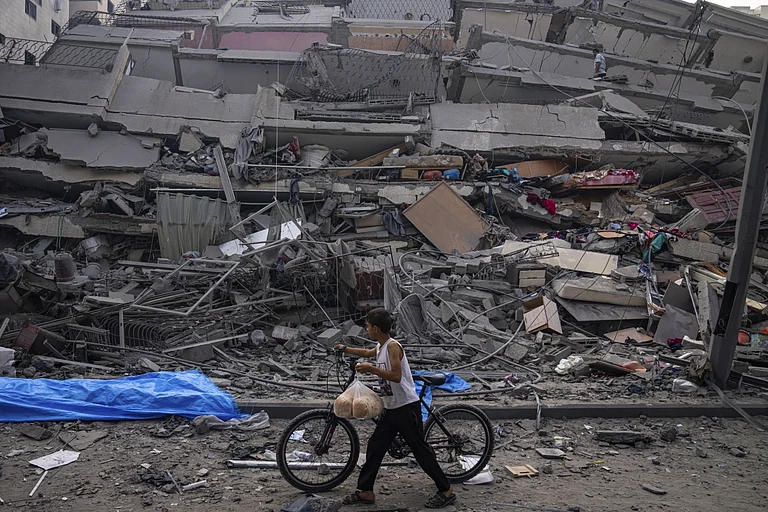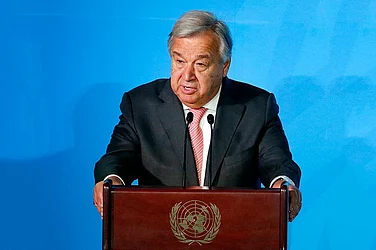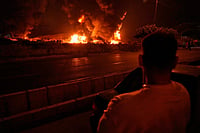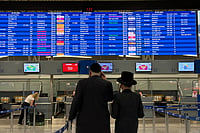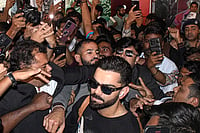A massive land convoy of activists, humanitarian volunteers, and civil society leaders is currently making its way from Tunisia toward the Gaza Strip, in what has become one of the most visible acts of global solidarity with Palestinians since the latest war began. Known as the “Soumoud Convoy”—Arabic for “steadfastness”—this transnational effort aims to deliver not just material aid, but a potent message of resistance against the ongoing siege of Gaza.
The convoy set off on June 9 from Tunisia, where a coalition of labour unions, human rights organisations, lawyers' associations, and student groups gathered to launch the initiative. According to reporting by the Associated Press, the convoy includes more than 1,200 participants from over 50 countries, and is composed of buses and private vehicles carrying medical supplies, food parcels, and solidarity banners. The convoy travelled through southern Tunisia and has already crossed Libya, with stops in Tripoli, Misrata, and Benghazi.
Organisers have emphasised that the real goal of the convoy is not only to deliver aid, but to reignite international pressure on Israel and Egypt to open the Rafah border crossing, Gaza’s main lifeline to the outside world. “This is a march of conscience,” said Tunisian journalist and convoy participant Ghaya Ben Mbarek, in remarks published by the AP. “We cannot remain idle while children starve and Gaza is turned into a graveyard.”
The journey comes at a time when the humanitarian situation in Gaza has reached a new level of desperation. Since October 2023, when Hamas militants launched a deadly attack on southern Israel and triggered a massive Israeli military response, Gaza has been subjected to a near-total siege. According to Reuters, more than 37,000 Palestinians have been killed so far, with tens of thousands more injured, and nearly all of Gaza’s 2.3 million residents displaced or affected by the conflict.
The Rafah border crossing, Gaza’s main passage into Egypt, has been closed for most of the past year. Egypt has allowed very limited movement of injured persons and dual nationals, but has so far resisted calls to fully open the crossing for humanitarian deliveries. Meanwhile, the United Nations World Food Programme (WFP) and other international agencies have repeatedly warned that Gaza is on the brink of famine. As of early June, UN OCHA estimates indicated that over 500,000 people in Gaza face catastrophic levels of food insecurity.
Against this backdrop, the Soumoud Convoy has gained visibility not only for its scale but for its symbolism. Many of its organisers and participants see the initiative as part of a larger movement to reclaim humanitarian solidarity from political paralysis. In an interview with the Press Trust of India (PTI), an Algerian activist said, “Our demands are simple: Let the aid in. Let the people breathe. Let humanity be the guide, not politics.”
The convoy’s progress has been smooth so far, with logistical support from local authorities in Libya, according to PTI. The group is currently in eastern Libya, preparing to enter Egypt through the Sallum border post. The final goal is to reach the Rafah crossing in mid-June, where the convoy hopes to stage a peaceful demonstration and, if allowed, deliver aid directly to Gaza.
Although the convoy does not expect to break through the border on its own, organisers believe the action will generate international pressure and renew calls for an end to the siege. Some participants have drawn inspiration from the Freedom Flotilla, a maritime mission that aimed to reach Gaza by sea but was intercepted by Israeli forces in early June. That flotilla included high-profile activists like Greta Thunberg and was halted in international waters before being redirected to Israel’s Ashdod port. According to AP and Reuters, many passengers were detained before being deported, prompting widespread condemnation.
These incidents, activists argue, underscore the urgency of land-based missions like the Soumoud Convoy. “Every time the sea is blocked, the land must answer,” said one Moroccan participant in a recorded statement shared by the convoy’s media team. “This is not just about trucks. It’s about breaking the silence.”
Critics of the convoy—including some Israeli officials—argue that such missions risk politicising humanitarian work or could inadvertently support Hamas, which controls the Gaza Strip. However, convoy leaders insist their effort is entirely civilian, independent, and guided by humanitarian principles. “This is not an endorsement of any faction,” one spokesperson told Reuters. “It is an endorsement of life.”
Meanwhile, alternative aid delivery systems have come under fire. The U.S. and Israel recently created the Gaza Humanitarian Foundation (GHF), a private aid mechanism meant to bypass what they view as compromised UN agencies. However, this foundation has faced criticism for its chaotic distribution methods, including deadly stampedes. According to Reuters and Gaza’s health ministry, more than 160 Palestinians have been killed during aid distributions coordinated by the GHF since late May. On June 3 alone, at least 27 people were killed by Israeli gunfire while trying to collect food at a GHF site in Rafah, prompting UN calls for an independent investigation.

UN agencies, including the WFP and UNICEF, have distanced themselves from the GHF, saying aid must be distributed under internationally recognised and impartial channels. For Soumoud Convoy organisers, this is further proof that grassroots, people-led movements must step into the void.
The Egyptian government has not formally approved the convoy’s final leg through Sinai. But discussions are ongoing between organisers and Egyptian civil society groups, and a diplomatic delegation is reportedly seeking third-party mediation. Several European parliamentarians and African Union observers are said to be joining the convoy in Cairo to increase international legitimacy.
If the convoy reaches Rafah by mid-June, it would represent the largest coordinated civilian action for Gaza since the Gaza Freedom March of 2009. Even if the convoy is blocked at the border, its leaders believe they will have succeeded in amplifying Gaza’s humanitarian crisis on the world stage.
“We will walk to the gate if we must,” said one of the organisers from Tunisia. “Because every day that gate stays shut, another child dies.”
As the convoy continues its journey through North Africa, the question reverberates far beyond its dusty roads: Will the world listen, not only to the weapons, but to the will of the people?
Detention of Maktoob Media Journalist Nikita Jain in Egypt: A Press Freedom Concern
On June 13, 2025, Nikita Jain, a journalist working with Maktoob Media, was detained by Egyptian authorities while reporting on the Global March to Gaza near the city of Ismailia. Jain, who was covering the protest as part of her journalistic duties, was among approximately 100 individuals apprehended as they attempted to approach the Rafah border crossing into Gaza. The march involved more than a thousand peace activists and journalists from around the world, including participants from India, the United States, France, and several Middle Eastern and North African nations. According to The Siasat Daily, those detained were stopped at various checkpoints, had their passports seized, and were barred from recording or photographing the events on the ground (source).
Maktoob Media released a statement confirming Jain’s detention and emphasised that she was present solely in her capacity as a journalist, not as a political activist. They also raised concerns about the treatment of foreign nationals and press members in the country. The broader operation carried out by Egyptian security forces led to the detention and, in some cases, deportation of dozens of international protesters and journalists. Reports indicate that some detainees were sent back to cities like Istanbul, while others, including Jain, were held in Ismailia under unclear legal conditions. Video reports from independent sources also show authorities preventing any media coverage at the site, raising alarms over press freedom violations.
The incident has drawn criticism from international rights organisations and media watchdogs, who view it as part of a larger pattern of suppression against both local and foreign journalists reporting on the Israel-Palestine conflict. As of now, Jain’s legal status and potential release remain uncertain. Her case has become a symbol of the growing risks journalists face when reporting from conflict zones, particularly under authoritarian regimes. Maktoob Media continues to advocate for her immediate release and reiterates its commitment to independent journalism despite mounting challenges.










